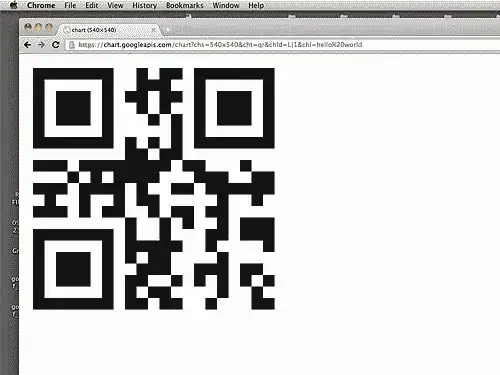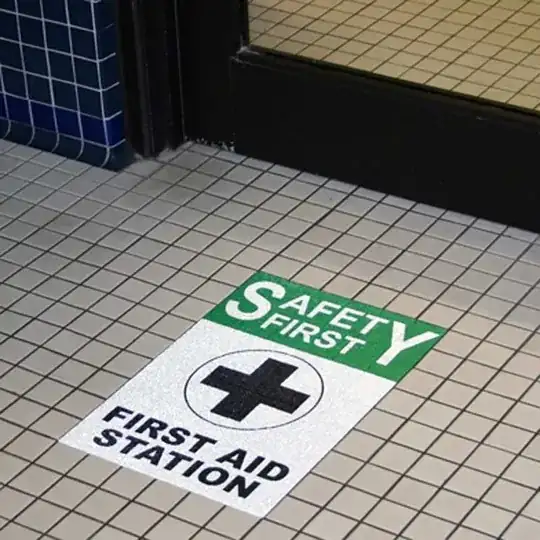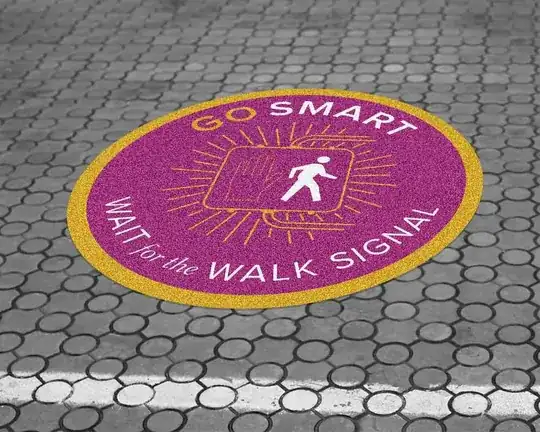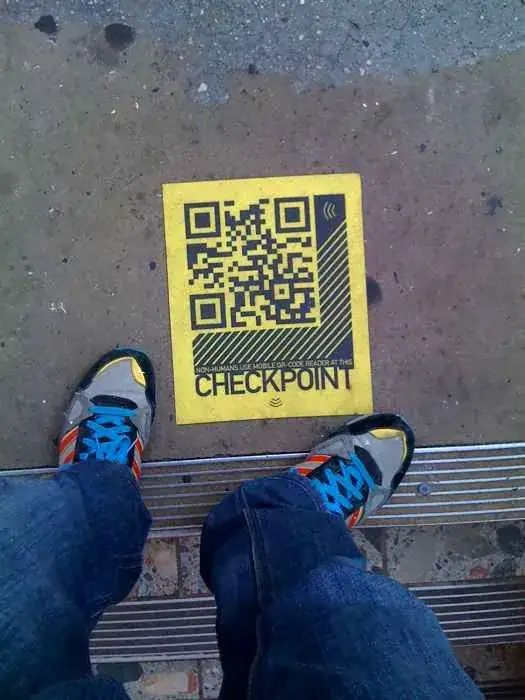The QR would be of a URL. The QR should be big enough like 4 A4 size papers. I though of cutting out the white boxes from a printed paper and spray on it but what about white dot islands. The precision needs to be good enough for a cell phone camera to detect it on the floor from standing distance.
-
3How about making two copies of the QR code and in each version cut out the boxed from every second row only. Then spray one stencil first and place the second stencil at the same position before you spray it (the result will depend on how exact you can position both stencil at the same spot...) – samcarter_prepared_for_xmas Jun 23 '19 at 17:37
-
1thats a great way to solve the islands. ill try. – thevikas Jun 23 '19 at 18:10
-
5Related - with what are you spraying? What's the drying time and bleed characteristics? Do you expect this tag to last an hour, a day/week/month or as long as possible? Sprinkled chalk dust could last as little as minutes depending on the traffic level. You may consider overspraying your tag with a clear-coat laquer for increased durability. Do you have permission to tag the pavement like this - and if not, should you ? Consider, this may diminish your brand not enhance it. – Criggie Jun 24 '19 at 04:27
-
Sprying with regular spray can. I guess the QR should be good to read for least few weeks. Its not on road. But places where it is safe for people to stand or wait. Its not commercial but to encourage citizen activism. – thevikas Jun 24 '19 at 10:47
-
2 A4 = 1 A3, 4 A4 = 2 A3 = 1 A2 – Jasper Jun 24 '19 at 12:27
-
It is worth noting that QR codes have redundancies, so even if they have some defects, they are still readable. You could read more about QR codes redundancies here: https://stackoverflow.com/questions/49287574/how-to-estimate-a-qr-code-redunduncy-level – adl Jun 24 '19 at 02:35
-
4Not directly related to answering your question, but depending on the type of footpath (indoor/outdoor), consider using reverse graffiti (https://en.wikipedia.org/wiki/Reverse_graffiti) instead of spraying paint for a much more environmental friendly solution. (also solves some concerns of @Criggie) – BrtH Jun 25 '19 at 08:33
-
7I might be out of touch, but do people these days tend to scan random QR codes that they see in the street? It doesn't seem to be much different than clicking random links in spam emails. – Aaron F Jun 25 '19 at 09:17
-
@AaronF Scanning a QR code usually shows you the URL first, and then after that you can tell your phone's browser to navigate to it. – Pyritie Jun 25 '19 at 12:59
-
6@thevikas "Its [...] to encourage citizen activism." Oh, great. Somebody who thinks vandalism is a good way to promote civic responsibility. – David Richerby Jun 25 '19 at 13:14
-
Ouch. I think I have to explain further. :) The first example is a many adult size open manholes near the street of my home. Do you still think vandalism is going to be something to worry about there? – thevikas Jun 25 '19 at 14:02
-
3@thevikas What's your goal? If it's to get the manholes fixed, you should talk to the people responsible for them and/or the city council. Neither of those things involves graffiti. If that doesn't work, contact local newspapers. I don't see how spraying QR codes on the ground is going to help get people to work with you, especially when they're in a place where they have to watch their step to avoid serious injury. Why not just put up posters? If people find the poster interesting, they'll read it. I doubt many people are going to scan random QR codes just to see if they point somewhere good. – David Richerby Jun 25 '19 at 14:53
-
Thanks for lot of ideas. Th current experiment is to check if people do something with QR. The URL which lists all the name, designation, phone numbers and office address of the staff responsible to keep this road safe. Nobody of our learned citizens knows who to call for this(or any other civic) problem. If the experiment fails do to anything, it simply ends the experiment in a sad way. – thevikas Jun 25 '19 at 15:17
-
3@thevikas Then I definitely suggest posters. With QR codes, people have to be curious enough to scan the code (an action that has no obvious benefit to them) and then interested enough to actually call the council. With posters, you're not filtering people based on how willing they are to waste their time scanning a QR code that could point to literally anything. – David Richerby Jun 25 '19 at 15:47
-
1Instead of spraying paint on the footpath, which could be seen as vandalism, how about you use a high pressure cleaner? There's a technique to "paint" something on a street or sidewalk by cleaning the dirt on the painted part instead of adding "dirt" to it. It's sometimges called Reverse Graffiti: https://www.youtube.com/watch?v=LI4zdyu30nw. Edit: seems like this was mentioned by @BrtH already – BlueCacti Jun 26 '19 at 07:09
-
1"The URL which lists all the name, designation, phone numbers and office address of the staff responsible" Do you have permission from that staff to do this? – Mast Jun 26 '19 at 09:57
-
fred_dot_u's answer was pretty fantastic and reminded me of the fact that QR codes can have error correction built in. It's probably possible to use a high enough error correction rate that you can just ignore several bits, connecting any islands with "flipped" bits. – Wayne Werner Jun 25 '19 at 17:52
-
If someone had asked me about this ten minutes ago, I would have said that it would never have worked because of the registration marks, but I just tried it and it actually works pretty well. It can get pretty tedious to stamp out all of the islands though. – Nonny Moose Jun 25 '19 at 21:12
-
Yeah, but probably just about as tedious as making two stencils I'd guess. It would be pretty neat if you could automate the process! – Wayne Werner Jun 25 '19 at 23:36
-
@mast Its a public office and the staff are public servants. – thevikas Jun 26 '19 at 16:05
6 Answers
Here's a QR Code Stencil Generator which automatically generates thin bridges between islands.
As mentioned by @Aloisdg : It is a Processing project and it is hosted on GitHub.
I tested it successfully on the pavement last year. The pavement should be as slick as possible, though.
- 431
- 4
- 6
-
4Great answer. It is a Processing project. Link to the GitHub repository – aloisdg Jun 24 '19 at 16:06
-
One approach to avoid the "island" problem could be to split the pattern into two stencils. In each stencil only the holes of every other row are cut out.
First colour is applied to one of the stencils. Then the stencil is exchanged and the colour is applied to the other stencil.
The weak point of this approach is that both stencil need to be placed at the same position.
- 466
- 1
- 7
- 13
-
12Real QR codes have registration marks in three corners. You should be able to make use of those to align the stencils. Instead of adhering strictly to the every-other row thing, you can include overlapping opposite "C" shapes of the registration marks, without violating the no-islands constraint. – hobbs Jun 24 '19 at 02:51
-
-
-
2@thevikas If you look at a QR code, it has nested Black and White squares in the corners (3 large, 1 small). On both stencils, include 3 sides of each square, so that 2 sides overlap and are shared between stencils. Then you can use those to line the second stencil up – Chronocidal Jun 24 '19 at 15:21
-
2Alignment could be done using a cardbard box with no top, and the bottom flaps folded out. User stands on two flaps to hold box position between sprays, and the sides will help stop overspray. OR a flat frame with two flaps held in on one side by tape hinges, so they can be folded out. – Criggie Jun 25 '19 at 04:39
- 974
- 6
- 15
-
1The target size being asked for is 4 sheets of A4 paper. That'd be a huge roller and well beyond what typical consumer 3rd printers can do. – Dan Is Fiddling By Firelight Jun 24 '19 at 17:36
-
3Unlike the other examples given on this page, my QR code reader is unable to read this one, or even identify it as a QR code. – Mark Jun 24 '19 at 21:27
-
-
@Danielillo: Shouldn't flipping not have any effect on QR code? Aren't the 3 identical corners for orientation? – Eric Duminil Jun 25 '19 at 14:00
-
I have not idea, maybe is the Photoshop editing. The original QR code used is the one from the Spanish Wikipedia – Danielillo Jun 25 '19 at 14:09
-
1
Instead of spraypaint - consider a "pavement sticker" or "footpath decal" that looks something like these.
A brighter background colour will help it stand out much more than paint on a dingy pavement/sidewalk. And you can peel, stick, stomp and go, whereas paint takes at least a minute to be touch dry, risking people standing in your tag.
Paper won't last very long, which might be suitable for your needs. A solid vinyl sticker could last up to years.
- 326
- 3
- 9
How about buying some grid-shaped welded wire metal mesh (commonly used for rabbit or chicken hutches), and using sticky tape to cover the squares you want to mask?
The wires would be thin enough that they wouldn't affect the scan, but strong enough to support isolated islands (much stronger than relying on tiny thin pieces of paper or card, which might break once they've been soaked in paint). More importantly, it would be quicker to make than a hand-cut stencil and you wouldn't need any expensive machines like a CNC router or 3D printer.
I recommend buying a flat sheet, the stuff that comes on a roll is usually twisted and won't lie flat.
- 191
- 3
-
1I've used this, worked pretty well. Covered the whole grid in tape and then used a sharp knife to cut out the stencil. – NotAGenie Jun 26 '19 at 11:15
-
@NotAGenie - that's interesting, I was thinking that you'd use (for example) a 1" grid with 1" tape, and just wrap tape around the squares or lines you want to mask – Robin Bennett Jun 26 '19 at 11:26
Your islands can become insignificant by creating stencil like bridges to the more solidly founded segments. A bridge of a few millimeters will bleed paint underneath but also will be small enough to be ignored by the QR software from a distance appropriate to the size of the code print. If the few millimeters is excessive, hot glue applied to ordinary sewing thread in more locations (spider web?) will provide the support and almost assure bleed under.
- 7,454
- 1
- 9
- 14
-
2QR codes are specifically designed to withstand a moderate number of single-pixel errors, so even if the few millimeters is excessive, you may be able to leave it there anyway. – Kevin Jun 24 '19 at 06:24





